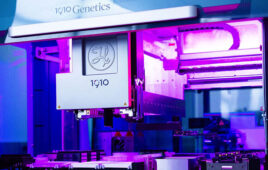
To harness CRISPR’s gene-targeting ability, the researchers took a deactivated Cas9 protein — a variant of Cas9 that can find a specific location on DNA, but doesn’t cut it — and tethered it to transistors made of graphene. When the CRISPR complex finds the spot on the DNA that it is targeting, it binds to it and triggers a change in the electrical conductance of the graphene, which, in turn, changes the electrical characteristics of the transistor. Credit: Keck Graduate Institute
A new handheld device that combines CRISPR technology with graphene-based electronic transistors can rapidly detect specific genetic mutations.
Researchers from the University of California, Berkeley and the Keck Graduate Institute of The Claremont Colleges have created the CRISPR-Chip device that can in just a few minutes diagnose genetic diseases or evaluate the accuracy of other gene-editing techniques. The researchers already used the device to identify genetic mutations in DNA samples from Duchenne muscular dystrophy (DMD) patients.
“We have developed the first transistor that uses CRISPR to search your genome for potential mutations,” Kiana Aran, an assistant professor at KGI who conceived of the technology while a postdoctoral scholar in UC Berkeley bioengineering professor Irina Conboy’s lab, said in a statement. “You just put your purified DNA sample on the chip, allow CRISPR to do the search and the graphene transistor reports the result of this search in minutes.”
While the majority of genetic testing techniques, including other CRISPR-based diagnostic tests, the new CRISPR-Chip uses nanoelectronics to detect genetic mutations in DNA samples without needing to amplify or replicate the DNA segment millions of times over in a time and labor intensive process called polymerase chain reaction (PCR).
“CRISPR-Chip has the benefit that it is really point of care, it is one of the few things where you could really do it at the bedside if you had a good DNA sample,” Niren Murthy, a professor of bioengineering at UC Berkeley and co-author of the paper, said in a statement. “Ultimately, you just need to take a person’s cells, extract the DNA and mix it with the CRISPR-Chip and you will be able to tell if a certain DNA sequence is there or not. That could potentially lead to a true bedside assay for DNA.”
In recent years, CRISPR-Cas9 has become an increasingly popular genetics tool, giving researchers the ability to snip threads of DNA at precise locations to edit-genes.
However, for the Cas9 protein to accurately cut and paste genes, it must be equipped with a snippet of a guide RNA to locate the exact spots in the DNA that need to be cut. Guide RNA is a small piece of RNA whose bases are complementary to the DNA sequence of interest. The bulky protein first unzips the double-stranded DNA and then scans through it until it finds the sequences that matches the guide RNA and then latches on.
The researchers used a deactivated Cas9 protein, a variant of Cas9 that can find a specific location on DNA but does not cut it, to harness CRISPR’s gene-targeting ability, which they tethered to transistors made of graphene. After the CRISPR complex finds the right spot on the DNA, it binds to it and triggers a change in the electrical conductance of the graphene, which then changes the electrical characteristics of the transistor. The researchers can detect these changes with a newly developed hand-held device.
“Graphene’s super-sensitivity enabled us to detect the DNA searching activities of CRISPR,” Aran said. “CRISPR brought the selectivity, graphene transistors brought the sensitivity and, together, we were able to do this PCR-free or amplification-free detection.”
In testing, the researchers used the device to detect a pair of common genetic mutations in blood samples from DMD patients.
“As a practice right now, boys who have DMD are typically not screened until we know that something is wrong, and then they undergo a genetic confirmation,” Conboy, who is also working on CRISPR-based treatments for DMD, said in a statement. “With a digital device, you could design guide RNAs throughout the whole dystrophin gene, and then you could just screen the entire sequence of the gene in a matter of hours. You could screen parents, or even newborns, for the presence or absence of dystrophin mutations— and then, if the mutation is found, therapy could be started early, before the disease has actually developed.”
Rapid genetic testing could also be used to help doctors develop individualized treatment plans for their patients.
“If you have certain mutations or certain DNA sequences, that will very accurately predict how you will respond to certain drugs,” Murthy said.
The study was published in Nature Biomedical Engineering.
Filed Under: Genomics/Proteomics




